このサイトの推奨ブラウザはGoogle Chromeです

令和2年度日本博主催・共催型プロジェクト
日本博を契機とした障害者の文化芸術フェスティバル2020年2月から2022年2月まで
Art Brut CREATION NIppon from 2.2020 to 2.2022
このサイトの推奨ブラウザはGoogle Chromeです

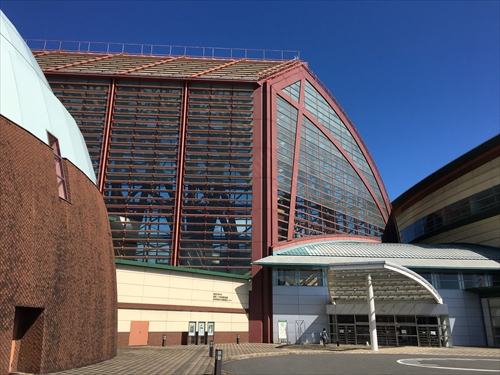
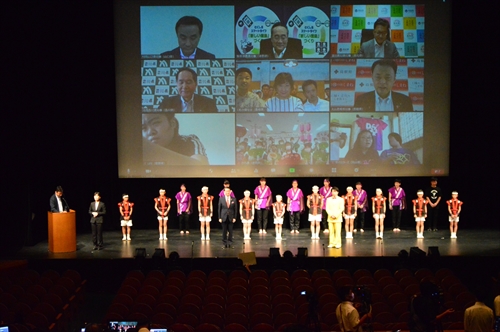
2020年9月5日(土)〜6日(日)の2日間に渡り、鳥取県倉吉市の倉吉未来中心を会場に、「日本博を契機とした障がい者の文化芸術フェスティバルin中国・四国ブロック」が中国・四国の各県を結んで開催された。映像によるライブ配信として行われた、大ホールのステージイベントと、アトリウムで行われた障害者によるステージ発表・パフォーマンス。会場開催となった「アール・ブリュット-日本人と自然-」の様子を、倉吉市の魅力とともにレポートする。
Over two days from September 5th (Sat) to 6th (Sun), 2020, at the Kurayoshi Mirai Chushin in Kurayoshi City, Tottori Prefecture, the "Art Brut CREATION Nippon in Tottori" was held jointly by the Chugoku and Shikoku prefectures. The stage events held in the Large Hall and disabled people’s stage performances held at the atrium that were live streamed, and this is a report on the exhibition "Art Brut; Humanity and Nature in Japan-" held at the venue, along with the appeal of Kurayoshi City.
オープニングのパフォーマンスは、打吹童子囃子(うつぶきどうじばやし)と、琴の浦高等支援学校ダンス部とのコラボレーション。続いて平井伸治鳥取県知事から「共に生きる社会を、文化芸術の力で作っていきたい」と、障害者アート推進のメッセージが発信された。あわせて開催ブロックの5つの県知事からも、オンラインでメッセージが。出演者の紹介の後に、スペシャルサポーターのダンディ坂野氏と一緒に、「鳥取から元気をゲッツ!」との開会宣言で、スタートとなった。
The opening performance was held in collaboration between Utsubuki Dojibayashi and Kotonoura High School Dance Club. Thereafter, Shinji Hirai, the governor of Tottori Prefecture, issued a statement to promote art of disabled people, saying, "Our desire is to create a society where we can live together with the power of culture and art." Also, messages from the five prefectural governors of the events were distributed online. After introducing the performers, the opening declaration of "Tottori kara Genki wo Get's (Getting energy from Tottori!" was kicked off with special supporter Dandy Sakano.
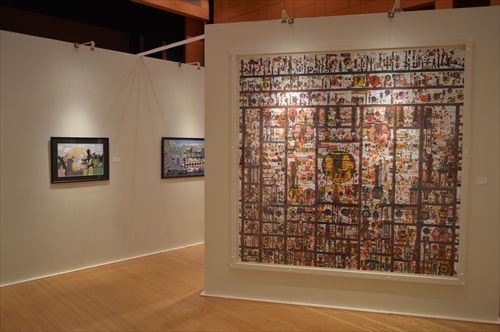

「日本人と自然」を障害者の芸術作品により、国内外に発信する展覧会。グランドオープニング出展作品の一部に加え、中国・四国の各県から、テーマである日本の自然観を思わせる作者が選出された。「アール・ブリュットを初めて見る人が多くいることを考えた構成とした」と、障害者の創作活動を支援する組織「あいサポート・アートセンター」の企画相談員で本企画展を手掛けた、森下真后氏は語る。以下、中国・四国地域の作家の作品について、1~3の展示セクションごとに企画展担当者の解説を交えて紹介する。
This exhibition showcases, both domestically and internationally, "Humanity and Nature in Japan" through works of art by disabled people. In addition to some works exhibited at the grand opening, authors reminiscing the theme of Japan's view of nature were selected from each prefecture in Chugoku and Shikoku. Mami Morishita, who worked on this exhibition as a planning counselor of the "Ai Support Art Center," an organization supporting the creative activities of disabled people, mentioned, "The design was created by considering many people viewing Art Brut for the first time." We will introduce below the works of artists from the Chugoku-Shikoku region, with explanations from the person in charge of the exhibition, for each of the first to third exhibition sections.
1.点と線と面…世界を構成する3つの要素。点が繋がって線になり、線が重なって面になる。
1.Points, lines, and surfaces: The three elements that make up the world. The points connect to form a line, and the lines overlap to form a surface.
森脇高広〈鳥取県〉 / Moriwaki Takahiro( Living in Tottori Prefecture)
画用紙いっぱいに色を塗り合わせた作品で、作者の感情を可視化したもの。色で画用紙を埋めていくように描き進め、色を混ぜないため原色のカラフルさが際立っている。モチーフ、パーツの大小、天地の方向に決まりはなく、見る側に委ねられている。
This workpiece fills the drawing paper with colors and visualizes the author's emotions. The colorfulness of the primary colors stands out as they are not mixed, and the drawing paper is filled with colors. There are no rules around the motif, the size of the parts, and vertical directions, and they are left up to the observer.
中山正仁〈高知県〉 / Nakayama Masahito(Living in Kochi Prefecture)
絵は入院した病院で看護師に描き方を習ったという。美人画をはじめさまざまなモチーフ、心象風景を描く。作品はモチーフがあるか、自身が見たり体験した題材から制作。かつて水産高校に在学し、外国航路への乗船歴があり、「外国航路」はその体験から描かれている。
A painting created by learning how to draw from a nurse at the hospital. Drawing various motifs and spiritual landscapes, including the Bijin-ga (Ukiyoe drawing of females). Whether a motif exists, the work is created from subjects observed and experienced. Once attending a Fisheries High School and with a history of boarding foreign vessel routes, the "foreign routes" are drawn from experience.
2.輪郭…日本絵画の特徴ともいえる、輪郭で切り取るという行為。日本人の自然に対する視点から生まれた表現。
2.Contours: The act of cutting out contours, which is a characteristic of Japanese paintings. An expression created based on the Japanese people's perspective on nature.
徳原望〈山口県〉 / Tokuhara Nozomi(Living in Yamaguchi Prefecture)
広島のアート・ルネッサンス展に出展したり、依頼に応じた作品を描くなど、その名が知られたアーティストでもあり、図書館の壁画を手がけるなど作家としての活動を活発に行なっている。通所する施設にはギャラリーがあり、作品は地元の周南市で販売も。
This well-known artist, exhibiting at the Art Renaissance exhibition in Hiroshima and drawing works upon request, is actively engaged in activities as a writer, such as works on mural paintings in the library. In the gallery of the facility, works are also sold in the local Shunan city.
戸舎清志〈島根県〉 / Toya Kiyoshi(Living in Shimane Prefecture)
定規とボールペンによる直線的な俯瞰図。車と家の屋根と電線が規則的な配列で、近づいてみると画面全体は、角度が揃った直線の集合体となっていることがわかる。バスでの通勤風景を描いており、どの作品も視点と角度が同じ。膨大な数の車はすべて、覚えているメーカーと車種を忠実に書き込んでいる。
A linear bird's-eye view of a ruler and ballpoint pen. The rooftops of cars, houses, and electric wires are arranged systematically, and when one approaches it, the entire screen can be viewed as a collection of straight lines with the same angle. It depicts the scenery when commuting by bus, and all the works have the same viewpoint and angle. The vast number of cars are all faithfully inscribed with the make and model remembered.
石村嘉成〈愛媛県〉 / Ishimura Yoshinari(Living in Ehime Prefecture)
動物、虫など生き物を、図鑑的な観察眼で精緻かつダイナミックに表現する。版画は、高校の授業で版画の作品を褒められたことがきっかけで始めた。実際に見たものを表現しており、毎日つけている日誌、動物園訪問や旅行先での体験がモチーフになっている。
It expresses creatures such as animals and insects precisely and dynamically with a pictorial and observational vision. The author started printmaking when praised for his work in high school. It expresses what one actually sees, and the motif is a diary kept every day, a zoo visit, and experiences at a travel destination.
飛田司郎〈香川県〉 / Tobita Shiro(Living in Kagawa Prefecture)
片岡鶴太郎・岡本太郎に影響を受け、画角いっぱいに顔を大胆に描く。代表作は架空の人物を具現化した「きのしたかずこ」シリーズ。アクリルで描いた上にクレヨンを塗っており、間近に見ると塗りの厚みがある。特に目の部分は厚く塗られている。
Influenced by Tsurutaro Kataoka and Taro Okamoto, the face is boldly drawn in full angle. A masterpiece, the "Kinoshita Kazuko" series embodies a fictional character. Crayon is coated over acrylic paint, which has a thickness when viewed up close. The eyes are particularly thickly painted.
藤井将吾〈広島県〉 / Fujii Shogo(Living in Hiroshima Prefecture)
ロゴ、乗り物、キャラクターなど、街や旅先で見かけるアイテムを羅列。ピンクか黄色の背景にパーツが規則的に配列されるという構造が、定型のパターン。作者は外に出るのが好きで、広島の各地の街をよく知っているため、状況がリアルに表れている。
A complete list of items one can see in town and on the road, such as logos, vehicles, and characters. The standard pattern is a structure in which parts are systemically arranged on a pink or yellow background. As the author likes to go outside and is familiar with the cities of Hiroshima, the situation is realistic.
3.行為とかたち…立体やインスタレーションといった、そこにあるもの。つくるという行為を感じられるもの。
3.Actions and forms: Things that are there, such as solids and installations. One can sense the act of creating.
澤 泰地〈徳島県〉 / Sawa Taichi(Living in Tokushima Prefecture)
図鑑で調べた恐竜をワイヤーによる3次元作品へと仕立てる。ワイヤーによる制作は、学校の授業でも行われていて、他の生徒は本来は籠などの実用品を制作するが、作者は好きな恐竜を表現している。資料を収集して、色の案を数通り検討し、精密な設計図を作成した上で、制作にかかる。
The dinosaurs researched in the picture encyclopedias are formed into three-dimensional works with wires. Creations with wires are also conducted in school classes. While other students generally create practical items such as baskets, the author expresses his favorite dinosaurs. After collecting materials, examining several color proposals, and creating a precise blueprint, the creation starts.
Takeuchi Tomoaki〈岡山県〉( Living in Okayama Prefecture)
人形制作。人間の体の理想とするフォルムを追い続けている。紙粘土か樹脂粘土を整形して、削りも加えて仕上げている。かつては全身像を作っていて、さらに理想を追求して胴体を模索しているが、まだ道は半ばで「完成形はない」とも。
Doll production. He continues to pursue the ideal form of the human body. Paper or resin clay is shaped and then shaved to finish. Full-body images are created, and in pursuit of ideals to find a torso, the road has been traveled only halfway with "no completed form."
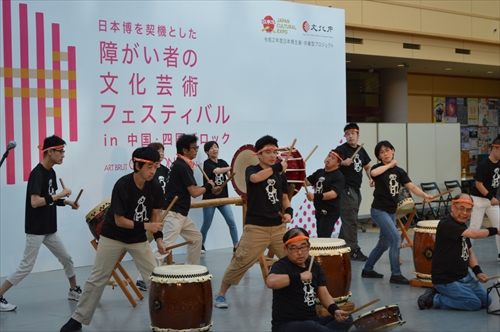

冒頭には、本作の演出家である中島諒人氏による作品説明があった。氏は鳥取県鹿野町で、廃校になった学校を劇場にして「鳥の劇場」という劇場と劇団を運営している。本作を演じるじゆう劇場は鳥の劇場がプロデュースし、2013年8月に活動を開始したプロジェクトで、障害のある人、ない人がいっしょに舞台を作りあげている。
At the start, Makoto Nakashima, the director, provided explanations of the work. In Shikano-cho, Tottori Prefecture, he runs a theater and theater company called "Tori no Gekijyou (Bird's Theater)" in a closed school building transformed into a theater. The Jiyu Gekijyo (Freedom Theater), which performed this work, is a project produced by the Tori no Gekijyo, which began its activities in August 2013, and those with and without disabilities create the stage together.
参加者は毎年公募しており、今年は14人プラス、鳥の劇場から3人の役者が合流。「マクベス」を大枠にしながら、他の戯曲や参加者の体験を織り交ぜて、権力の関係を表現している。
Participants are recruited every year, and this year 14 people and 3 actors from the Tori no Gekijyo took part. Using "Macbeth" as a general framework, the relationships of power were expressed by interweaving other plays and participants' experiences.
本作品はシェイクスピアの『マクベス』を題材に、マイノリティの立場から見た「権力」への欲望と抱える「壁」を、それぞれ織り込んで展開している。幕が開くと、まずはそれぞれの者が抱える「壁」の叫びから始まる。社会と関わりが持てない、人間関係が築けない、将来の居場所が不安など、社会との間に立ちはだかる越え難い「壁」を示す。『マクベス』のストーリーを主軸にしつつ、劇中に永山智行氏の『配役』という、障害者の総理大臣が誕生した世界を題材とする作品が唐突に入り込む。これらが「権力」とともに主題となり、シーンにより個々の役者が抱える「壁」が織り込まれていく展開となる。
Based on Shakespeare's "Macbeth," this work incorporates the lust for "power" from the perspective of the minority and the clasping "wall." When the curtains rise, the opening act starts with cries of the "wall" that each person retains. An insurmountable "wall" that stands in the way of society represents the inability to identify with society, failure to build human relationships, and anxiety about where to belong in the future. While focusing on the story of "Macbeth," a work called "Haiyaku (Casting)" by Tomoyuki Nagayama, a world where a prime minister with disabilities is brought into being is suddenly introduced into the play. These are the main subjects, along with "power," and the "wall" retained by each actor is woven into the scene.
石見神楽「大蛇」(おろち)/いわみ福祉会芸能クラブ
Performance of Iwami Kagura/Iwami Welfare Society Performing Arts Club (Shimane)
Program: Orochi
2020年9月6日(日)13:00~14:00
September 6(Sun),2020 13:00-14:00

社会福祉法人いわみ福祉会では1985年から芸能クラブが立ち上がり、石見神楽の上演に取り組んできた。金曜の夜を定例に、施設の利用者と職員で活動。はじめ余暇活動だったが次第に本格的になり、地域の神楽団体で構成される協議会に加入するに至った。本フェスティバルにてライブ配信した「大蛇」は、石見神楽の中でも屈指の人気がある演目だ。いわみ福祉会芸能クラブでは、同作品を2017年10 月にフランス・ナント市で開催された「2017ジャパン× ナントプロジェクト」で公演した実績も持つ。
At the social welfare corporation Iwami Welfare Society, an entertainment club was established in 1985 to work on the performances of Iwami Kagura. The facility users and staff carry out activities on Friday nights. What began as leisurely activities gradually became full-scale, and it led to their joining a council composed of local kagura groups. The "Orochi," which was live-streamed at this festival, is one of the most popular performances in Iwami Kagura. The Iwami Welfare Society Performing Arts Club has a track record of performing the same work at the "2017 Japan x Nantes Project" held in Nantes, France, in October 2017.
「大蛇」は日本古来から伝わる神話、八岐大蛇伝説を基にしており、大蛇が舞台狭しとのたうち回る、迫力がある演目である。八頭の大蛇が登場すると、縦になり積み上がり横になり巻き上がり、互いに絡みつき編み込まれ渦を巻き、と大暴れ。大蛇は長さ18メートル、重さは12キロあり、演者の体を見せずにひとりで回すのは大変な体力と技量が必要なのだとか。須佐之男命と大蛇が対峙する場面は、本作の見せ場。危機を乗り越えながら、須佐之男命が大蛇の頭を一つひとつ切り落としていく。囃子のスピードもあがり、舞台は最高潮に。
"Orochi" is based on a myth of ancient Japan, the legend of Yagi Orochi. The powerful performance showcases the Orochi fluttering around the stage. When the eight snakes appear, they run vertically, pile up, lay down, roll up, and entwine with each other, weave into a whirlpool, and go on a rampage. The snake is 18 meters long and weighs 12 kilograms, and it takes vast physical strength and skill to turn around alone without revealing the performer's body. The scene where Susanoo-no-Mikoto and the Orochi confront each other is the highlight of the work. Overcoming crisis, Susanoo-no-Mikoto cuts off the heads of the snakes one by one. The Hayashi (musical accompaniment) also speeds up, and the stage reaches a climax.
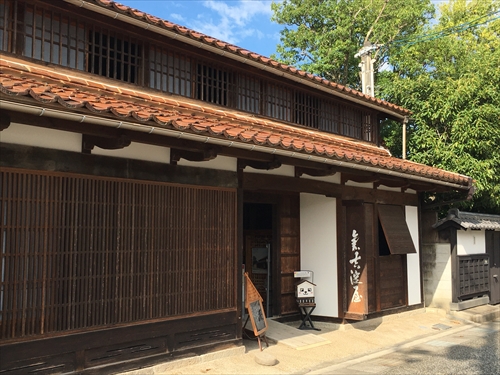
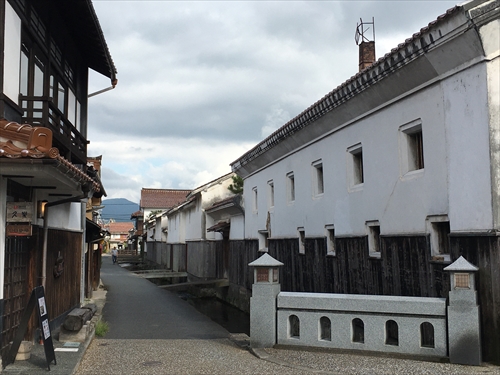
「日本博を契機とした障がい者の文化芸術フェスティバルin中国・四国ブロック」の会場となった、鳥取県倉吉市。県の中央に位置し、周囲を温泉に囲まれた緑豊かな環境で、会場に近接した町並みは「倉吉・打吹玉川伝統的建造物群保存地区」に指定されている。その中には、昔ながらの蔵を活用した、障害者の文化芸術活動の拠点となる施設もある。「日本人と自然」とのつながりの深い、文化芸術が育まれる土壌といえるだろう。そんな地域性を背景として、本フェスティバルは開催された。地域の魅力をレポートする。
Kurayoshi City, Tottori Prefecture, was the venue for the "Art Brut CREATION Nippon in Tottori". Located in the prefecture center, surrounded by hot springs, the townscape near the venue is designated as the "Kurayoshi / Uchibuki Tamagawa Traditional Buildings Preservation District." Among them is a facility that utilizes the old-fashioned warehouse serving as a base for cultural and artistic activities for disabled people. This is said to be the soil ground where cultural arts is nurtured, with deep connection to "Japanese and nature." This festival was held against the backdrop of such regional characteristics. We report on the appeal of the area.
街道筋に残る、商家の町並み
The streets of merchant houses that remain on the highway
町並みの中心は、本フェスティバル会場の倉吉未来中心からバスで5分、歩いても20分ほど。町内は「八橋往来(やばせおうらい)」という、伯耆国の中心であった倉吉と八橋を結ぶ、奈良時代からの街道筋。分岐に設置された道標が、今も残っている。元帥酒造本店は倉吉の典型的な町家で、間口が狭く奥が長く、一番奥に土蔵があるつくり。町内には仏師の彫った福の神の彫刻が各所にあり、こちらにある頭の長い福禄寿もその一つだ。
The center of the town is 5 minutes by bus or 20 minutes on foot from Kurayoshi Mirai Center, the festival's venue. The town is called "Yabase Ourai," a highway from the Nara period that connects Kurayoshi and Yatsuhashi, which was the center of the Hoki Province. The signboard installed at the junction remains. The Gensui Sake Brewery Main Store is a typical townhouse in Kurayoshi, with a narrow front and an extended back area, with a storehouse at the very back. There are sculptures of the god of good fortune carved by Buddhist masters in various places across town, and the long-headed Fukurokuju placed here is one of them.
元帥酒造の付近が、八橋往来で古い建物が集中する地区で、商家のほか明治以降の洋館や商店も見られる。桑田醤油醸造場は、明治10年から現在も醤油を製造・販売している、当時の豪商の一つ。間口が26~7メートルと広いのが、豪商だったことを物語っている。
The area around Gensui Sake Brewery is the Yabase Ourai, a district where old buildings are concentrated. Merchant houses, Western-style buildings, and shops after the Meiji era can also be viewed. The Kuwata Soy Sauce Brewery was one of the wealthiest merchants at the time, producing and selling soy sauce from the 10th year of the Meiji era. The wide storefront of 26 to 27 meters demonstrates the wealth of the merchant.
玉川を渡った先の倉吉淀屋は1760(宝暦10)年建築の、倉吉に現存する最古の町家建築。間口は26メートル、内部は表が店の間で奥に生活の間、さらに客用の間。玄関は籠が直接入れる、珍しいつくりになっている。玉川沿いには長さ400メートルほどに渡り、白壁土蔵群の土蔵群が続く、江戸~明治期に防火用水の玉川沿いに造られ、蔵の基礎部分は倉吉産の安山岩を用いるなど、防火対策が施されている。
Across the Tamagawa River, the Kurayoshi Yodoya built in 1760 (Horeki 10), is the oldest existing Machiya building in Kurayoshi. The storefront is 26 meters in width, with the front interior consisting of shops, the back section forming living quarters and rooms for customers. The entrance is a rare structure where one can directly access a basket. White-walled warehouses stretching across for about 400 meters along the Tamagawa River, were built aligning the Tamagawa River for fire prevention measures during the Edo-Meiji period, and the foundations of the warehouse are made of andesite from Kurayoshi.
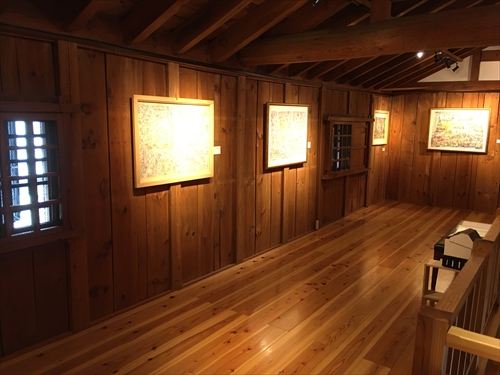

白壁土蔵群から街道を先ほどと反対方向へ歩くと、旧国立第三銀行倉吉支店の蔵を利用した、アートスペース「くらよしアートミュージアム 無心」がある。禅の境地とされる「無心」の名を持つこのミュージアムは前述の「あいサポート・アートセンター」が運営しており、町と福祉と文化の連携による独創的な活動をしている。同館では「障がい者の文化芸術フェスティバルin中国・四国ブロック」の開催に合わせて、『古久保憲満個展 饒舌な街』を開催した。作者の古久保氏が思い描く都市の絵を、蔵の中のスペースに展示。絵は日本のみならず世界の都市もモチーフにしており、すでにある都市に自らの精神世界も反映・詰め込みながら、独自の都市像を描いている。近年ではヨーロッパやアメリカをはじめ、世界的な評価も高まってきた。それに連れて絵を通じた社会との関わりも増えていき、今では展覧会や取材で海外へ行くこともしばしばあるそうだ。
Walking along the highway from the white-walled warehouses in the opposite direction, one will find an art space, "Kurayoshi Art Museum Mushin," which uses the warehouse vault of the former National Third Bank Kurayoshi Branch. This museum named "Mushin," known as the state of Zen is run by the aforementioned "Ai Support Art Center" and engages in creative activities in collaboration with the town, welfare, and culture. In the same building, the "Kokubo Norimitsu Solo Exhibition: Jyozetsu na machi (Talkative Town)" was held in conjunction with the "Art Brut CREATION Nippon in Tottori". A picture of the city envisioned by the author, Kokubo, is exhibited in the space inside the warehouse. The painting uses Japan and cities worldwide as motifs and draws a unique image of the city while reflecting and filling the existing city with its spiritual world. In recent years, it has been highly evaluated around the world in Europe and the United States. Along with that, his involvement with society through paintings has expanded, and he now often goes abroad for exhibitions and interviews.
作品は古久保氏が興味を持っている、世界の都市をはじめ船や車、軍艦などがモチーフだ。スマートフォンなどでデータを収集して描いており、展示作品はどれも緻密で情報があふれている。都市については特に細かく調べており、「きたちょうせんとアメリカのけいむしょをモデルにしたまち」では周囲の鉄条網が国境、壁がアッティカ刑務所を表現。「発展する中国天津市」にはたくさんの高層ビルにタワー、ジェットコースターが描き込まれる。タイトルは自身でつけており、「はってん」「けいざいかくめい」という前向きなワードが印象的だ。
いずれの作品からも、込められたあふれんばかりの情報が、見る者にまさに饒舌に語りかけてくる。伝建地区のしっとりした町並みとの緩やかな懇談に、饒舌な街との賑やかな会話から、倉吉の地域の魅力が発信されているようである。
Kokubo is interested in works with motifs of ships, cars, warships, etc., including cities worldwide. Data is collected with smartphones and drawn accordingly, with all the exhibited works full of detail and information. He has investigated cities in particular, and in "The town modeled after North Korea and the American Prison," the surrounding wire fences represent borders, and the walls represent Attica prison. Towers and roller coasters are depicted alongside many skyscrapers in the "Developing Tianjin, China." He applied the title himself, and the positive words "Development(Hatten)" and "Economic Revolution (Keizai Kakumei)" leave an impression.
The overflowing information contained in each of the works speaks to the observer in a very talkative manner. The charm of the Kurayoshi area appears to be conveyed through a gentle conversation with the smooth townscape of the Traditional Buildings district and a lively conversation with the talkative town.